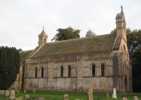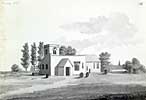 Thorney with Wigsley Thorney with Wigsley
St Helen
History
Thorney is mentioned in Domesday Book without any reference to a church. It formed part of the lands of the Bishop of Lincoln.
A church dedicated to St Helen had certainly been established by the beginning of the 13th century. In 1201, Walter de Clifford and his wife, Agnes, granted Thorney Church and 30 acres of land belonging to it, to Broadholme Priory, Nottinghamshire. Thorney appears to be the only church in Nottinghamshire appropriated to Broadholme, though the priory also held a variety of small temporalities in Lincolnshire.
In 1291, for the purposes of ecclesiastical taxation under Pope Nicholas IV, the church was valued at £8, while a vicarage attached to the church was valued at £4 6s. 8d.
In 1295 there was a dispute between Henry the vicar of Thorney and the prioress and convent of Broadholme regarding the portion due to the vicar. Archbishop Romeyn ordered the archdeacon's official to make judgement.
Writing to the dean of Newark in 1301 archbishop Corbridge requested the dean to cite the vicar of Thorney to appear at Newark St Mary to answer for certain objections at a previous visitation, but in two parts: on the Monday following the feast of St Matthias (27 February) as to the deanery on the east side of the river Trent, and again on the following Tuesday for the parts on the west side. There are now no parts of Thorney parish on the west side of the Trent and no lands are featured on the 1839 tithe map.
In 1310 Archbishop Greenfield authorized the nuns of Broadholme to retain Thorney church in proprios usus, at the same time praising them for their devotional fervour and acknowledging their piety and slender means which was the reason given for their retention of Thorney.
A further dispute involving the tithes of Thorney and the priory of Broadholme occurred in 1320 when seven witnesses were gathered in Torksey (originally meant to be at Stow) church in Lincolnshire to hear a complaint which had been brought against the vicar of Saxilby (Lincolnshire) by the prioress and convent. Unfortunately the articles of complaint are not listed; however, the outcome is given in March 1321 when archbishop Melton ordered the priory to surrender fleeces and lambs received during the dispute.
The constituent parts of the church’s value were recorded in 1341 for the purposes of a tax assessment under Edward III: the church derived its income – amounting to 18 marks (£12) 6 shillings and 8 pence – from a ninth of sheaves, fleeces and lambs valued at 12 marks (£8) and 5 shillings, 4 bovates of land valued at 3 marks, altar dues valued at 6 marks (£4), and tithes of hay worth 5 marks (£3 6s. 8d.) yearly.
In 1398 the vicarage of Thorney, but not the church, was taxed as part of the half a tenth granted to Richard II by the clergy of the province of York on 7 March 1395.
The value of the church remained the same at 12 marks (£8) by 1428, when the church paid a subsidy of 16s. during the reign of Henry VI. Following the dissolution of the monasteries under Henry VIII, Thorney Church and the right of patronage to the vicarage was granted to Edward Fynes, Lord Clinton and Robert Tyrwhit and their heirs, who soon afterwards conveyed it to others.
In the Valor Ecclesiasticus of 1534 the value of the lesser tithes of Thorney, still then appropriated by Broadholme priory, were worth 40s.
In 1601 the swornmen of the church reported that 'the church porch is forth of repair, because the lead of the same has been stolen'.
In 1613 an interesting incident occurred, reported by the churchwardens seeking Roman Catholics in the parish. They presented that:
'according to the warrant we have been to demand the names of the recusants at Brodholme [Broadholme]; they would not let us in, affirming that their mistress was not at home; we could not learn any of their names; the number of them is herself [the mistress] and usually two men and two maids; the rest of the tenants there have absented themselves from the church for the space of about two months, affirming that their landlord Mr Mathies has discharged them from coming to the church or paying any duties to the church or the parish; the names of the householders are Roberte Midleton and his wife, John Allandson and his wife, and Roberte Oxbey and his wife; Mr Matheis has a man that remains there for the most part, and never came to church; he has been there since May Day last'. Similar enquiries took place in 1614 and 1616, and in 1619 the minister and churchwardens reported that 'whereas there are certain popishly given people whose names we cannot learn at Brodholme [Broadholme] in the parish of Thorney alias Thornhaugh, and whereas divers other people resort there from other places, we therefore present as absolute recusants 'Old Taylor', his wife and his daughter'.
The reporting of recusants continues throughout the 1620s.
In 1635 the church was repaired in the sum of £4.
A full account of the parish was provided in 1743 by the curate, John Robinson, for the purposes of a visitation return submitted to Archbishop Herring. The small parish of Thorney contained only 34 families, none of whom were dissenters or nonconformists. There were no meeting houses located in the parish, and neither were there any alms houses nor any public or charity schools. The curate recorded that he resided in the vicarage, and provided the qualifying statement that he did so ‘by reason the living is extremely small and I am unmarried’. There was no other residing curate, and Robinson knew of no parishioner who had not been baptised, or, being of sufficient age, had not been confirmed. Public service was read only once every Sunday because the curate was responsible for another cure in the diocese of Lincoln. The curate catechised every Lent, and the sacrament was administered four times a year, with between 30 and 40 people having received the sacrament during the previous Easter. Due notice of the sacrament was provided on the Sunday before it was due to be administered, and Robinson recorded that he had never had any reason to refuse the sacrament to anyone. In reference to this latter point, the curate added in parentheses, and somewhat idiosyncratically, ‘I thank God’.
Robinson made the return in 1764 at the time of Archbishop Drummond’s Visitation, where there were 36 families, and no dissenters. He lived at Clifton, ‘my other living’, but took all the services, including Holy Communion four times a year.
 The church in 1773 The church in 1773 |
A description of Thorney Church was provided in 1796 by Throsby, who recorded that it comprised a low brick tower with two bells, a nave and a side aisle. In the chancel there was a monument commemorating Farrington Neville who died in 1760 aged 66, whilst a floor stone commemorated George Neville (d. 1742) and Catherine Neville, his wife (d. 1766).
In 1850, Thorney Church was entirely rebuilt by the architect L. N. Cottingham in the Norman style, with the costs of the work met entirely by the Rev. Christopher Neville and the Neville family. The new church was built of stone and consisted of a nave, chapel, and bell turret containing two bells. Seating was provided for 200 parishioners in the form of open pews, and the building was consecrated on 11 April 1850. Heating apparatus was installed some years later in 1892 at a cost of £55.
In his series The Buildings of England, Nikolas Pevsner commented that the architect of Thorney St Helen was ‘better known for his writing than his buildings’, and described the church as a ‘sumptuous ham-fisted Norman exterior, with west façade’. However, in The Shell Guide to Nottinghamshire, Henry Thorold gave a more favourable judgement, declaring that the church was ‘as magnificent as it was unexpected’.
In 1851, it was recorded in the religious census that the parish of Thorney consisted of the townships of Thorney, Broadholme, and Wigsley. Thorney contained a population of 191 parishioners, whilst the total population of the parish amounted to some 412 individuals. The church was endowed with tithes valued at £60, and glebe to the value of £80. Average attendance over a 12-month period amounted to 50 parishioners in the morning, and 70 in the evening for the general congregation, in addition to a total of 40 children enrolled in Sunday School. The area of the parish comprised 4,140 acres.
Thorney St Helen was visited by Bishop Edwyn Hoskyns on 9 March 1912. The vicar at this time was the Rev. J. Smith, and the church was valued at £165. The population of the parish amounted to 318 individuals, and the church provided accommodation for 200 parishioners. There were 65 children enrolled in the church day school, and a further 25 children enrolled in Sunday School.
On 14 March 1946 a faculty was issued to provide and place a mural tablet on the south side of the interior of the church commemorating Edward Farington Nevile, a long-serving churchwarden.
Correspondence held at Nottinghamshire Archives shows that there was some degree of confusion over this faculty, and the application to install the memorial tablet was initially rejected on the grounds that the proposed wording of the tablet contained no reference to service rendered by the deceased to Thorney Church. Apparently, the Rev. J. H. N. Tomsen, vicar of Thorney, had originally thought it unnecessary to include any such reference on the memorial tablet because the Neville family had lived in Thorney ‘for 400 years’ and were all buried in the church. In response to this, the chancellor of Southwell Diocese stated that the ‘mere fact that members of the family had been buried at Thorney for generations, though a good reason for an inscription on a gravestone, was not considered by itself a reason for a memorial in the church’. The wording for the planned memorial was consequently altered to record that Edward Neville had served as a churchwarden.
The parish register at Thorney dates from 1562.
| 


 The church in 1773
The church in 1773





